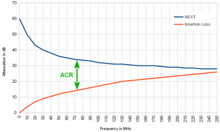Attenuation To Crosstalk Ratio
Attenuation To Crosstalk Ratio ( ACR ; German attenuation-crosstalk attenuation ratio , also crosstalk attenuation ) is the ratio of insertion loss (insertion loss) to crosstalk (NEXT) of a transmission path in a structured cabling .
The ACR value is given in dB and expresses the quality of the transmission path. The higher the value, the higher the quality of the transmission path (related to the frequency ).
Sample calculation
For a transmission link with a UTP cable, the insertion loss is 19 dB and the NEXT value is 82 dB. This means that the ACR value is 82 dB - 19 dB = 63 dB. Another transmission link has an ACR value of 50 dB, this transmission link has a poorer quality compared to the first-mentioned one, because the ACR value is lower.
Limit values according to standard
Smallest permissible ACR limit values in dB for class-specific frequencies.
| Class according to DIN EN 50173 | 100 MHz | 250 MHz | 600 MHz |
|---|---|---|---|
| Class D. | 11.9 | not defined | not defined |
| Class E. | 23.3 | 4.7 | not defined |
| Class F | 47.3 | 31.6 | 8.1 |
Others
For (digital) communications technology, it must be ensured that the ACR does not fall below 0 within the bandwidth to be transmitted . The ACR is comparable to the signal-to-noise ratio from telephony or any other transmission technology.
literature
- Michael Dickreiter, Volker Dittel, Wolfgang Hoeg, Martin Wöhr (eds.): Manual of the recording studio technology . 8th, revised and expanded edition, 2 volumes. Walter de Gruyter, Berlin / Boston 2014, ISBN 978-3-11-028978-7 .
Individual evidence
- ↑ DIN EN 50173-1, Information technology - Application-neutral communication cable systems - Part 1: General requirements
- ^ IT manual, 7th edition, Westermann Schulbuchverlag, Braunschweig 2011, ISBN 978-3-14-2250427 , p. 291.
Web links
- Structured Cabling Testing (accessed July 30, 2018)
- Cable Testing Definitions (accessed July 30, 2018)

